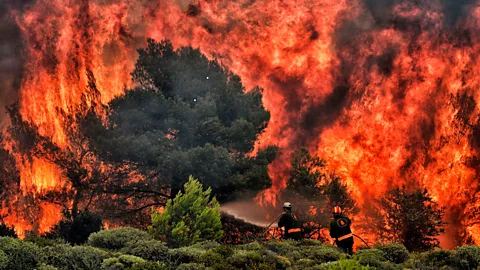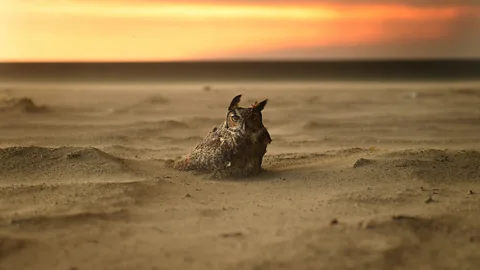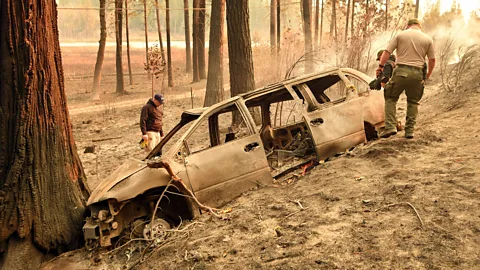Five myths about wildfires
 Getty
GettyAre wildfires a natural, if tragic, event – or are they getting worse with climate change? Would logging help decrease them? And can they be kept under control with forward planning? BBC Future debunks five common myths.
Canada is in the grip of what could be its worst wildfire season on record, causing smoke to spread across much of the country and north-eastern US. Cities such as New York and Toronto have seen air quality plummet as a result and it has led to warnings about the effects on human health.
The devastation wrought by wildfires has become a common horror story for those living in the regions hit by such blazes. A long-running drought in California has seen the state hit by successive years of devastating wildfires. At the end of 2019 and start 2020, Australia grappled with the worst wildfire season in its history. In 2018, a series of wildfires in the Greek coast killed around 100 people in the deadliest wildfire worldwide since 2009.
Siberia has also seen unusually widespread wildfires since summer of 2020, which have been linked to high temperatures in the region. The following year, more than 8.4 million hectares (32,400sq miles) of forests burned in Sakha, nearly four times the long-term average. This year has brought "significant" wildfire activity across the Urals, Kazakhstan and Mongolia, with hundreds of homes destroyed and a growing death toll. Smoke from fires in Russia regularly spreads around the world, reaching as far as major cities in North America. It has led some to claim that this is a new normal. (Read more about how smoke from wildfires causes harm thousands of miles away.)
But as fires multiply around the world, so do questions about them – and misconceptions. Here are five common myths about wildfires – some of which can undermine our success in fighting them.
 Getty
GettyMyth #1: Regularly logging forests prevents forest fires
A common assumption is that logging, or removing some trees, would prevent fires. In fact, many forest experts say that logging is ineffective. This is because the tree remnants left over after logging, such as stumps and branches, provide a super-fuel for fire – one that is even drier (and more flammable) in the absence of a forest canopy.
You might also like:
• The quest to predict – and stop – the spread of wildfires
There is plenty of science backing these claims. For instance, a recent study showed that burn severity tended to be higher in areas with higher levels of management. Scholars working on wildfire conservation have also rebuked arguments that logging protects endangered species from forest fires, a common argument in favour of tree removal; in fact, it seems that animals like the iconic spotted owl still benefit from a burned-out forest and that removing the trees could hurt them. Even post-fire logging is counterproductive and can lead to more fires.
A different practice is clearing entire areas of a forest, a common approach used by firefighters to prevent the fire from spreading.
 Getty
GettyMyth #2: There is nothing you can do to protect your property
Wildfires are powerful and threatening, but households can reduce their risk by taking action at home. The building itself should be the first concern. Houses with fire-resistant roofs stand a better chance of surviving a blaze. Owners also should remove combustible materials from around the structure, including leaves in gutters and rooflines.
Families can create a "defensible zone" between their homes and their surrounding wilderness. This means clearing anything that could catch fire, like brush, dried leaves and wood piles within 30ft (9m) of structures. When they are 30-100ft (9-30m) away from homes, trees should have large distances between canopies – 12ft (3.6m) of space between tops that are between 30-60ft (9-18m) from a home, and 6ft (1.8m) of space for tops that are 60ft (18m) away. This interrupts the fire's path and slows its pace.
 Getty
GettyMyth #3: Wildfires are an inevitable fact of nature
While wildfires are a natural phenomenon, the extent and intensity to which they're happening now is not. Rather, they are regarded as one of the effects of climate change.
We saw fewer fires between 1930 and 1980, a period that coincided with cooler and moister conditions. But as the climate has become hotter and drier in the last four decades, the number of fires have increased. In only two years between 1980 and 1999 did wildfires burn more than 6 million acres (2.4m hectares) of US wilderness. But between 2000 and 2017, there were 10 years with burnt acreage above that threshold.
 Getty
GettyMultiple scientific studies have found that climate change has increased the length of wildfire seasons, wildfire frequency, and the area burned area.
While you can't point to climate change as causing any particular fire on its own, it does influence factors that help spark and spread fires, like major drought, high temperatures, low humidity and high winds. As a result, scientists say that the increase of wildfires around the world, from Siberia to Portugal, is linked to climate change.
Myth #4: All wildfires are bad and must be quenched immediately
Fires have played a crucial role in ecosystems for millennia and life has evolved beside them: some beetles breed only in the heat of fires, pine cones germinate with periodical fires and cleared space from burnt trees allows for new plants to spring.
 Getty
GettyIn fact, the benefits that many people now hope to achieve with logging or forest management – the clearing of dense woods – is naturally done by forest fires. The flames periodically consume smaller branches and trees, culling the forest which otherwise would otherwise serve as fuel.
By fighting wildfires relentlessly during the past century, we have prevented this "cleansing": less than 1% of US fires are allowed to burn. This strategy works better when there are fewer wildfires – but in our current extreme conditions, pumping more money to fighting fires might have a diminishing rate of returns.
Myth #5: It is possible to eradicate (or control) all wildfires
As we have already seen, climate change, alongside other factors such as the spread of human settlements, is expected to increase wildfires, particularly in mid-to-high latitudes, in the coming decades. The tropics might see a decrease in fires, which might come as a relief for countries nearer the equator. But the rest of the globe would have to deal with an increasing number of them.
Some fires, like California's Camp Fire in 2018, are too fast to be managed. Evacuation and relocation are the only reasonable responses. This leads to the question of whether communities like Paradise, which was destroyed almost entirely by the fire, should stay where they are – or move elsewhere.
 Getty
GettySome experts are calling for a return to traditional indigenous fire knowledge to deal with the flames. As efforts to cull fires seem insufficient – and as fires are likely to only get worse – those are questions policymakers must face.
* This article was originally published on 13 November 2018, but has been updated to reflect the ongoing wildfires affecting North America.
--
